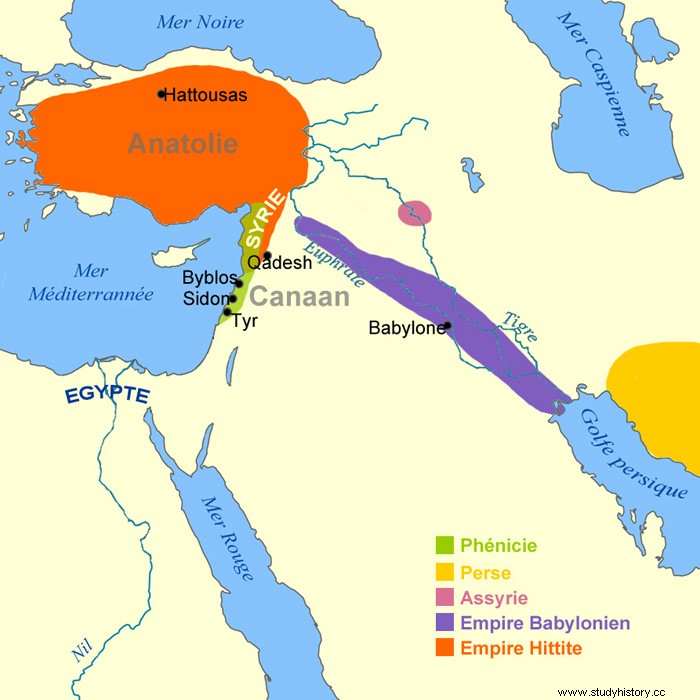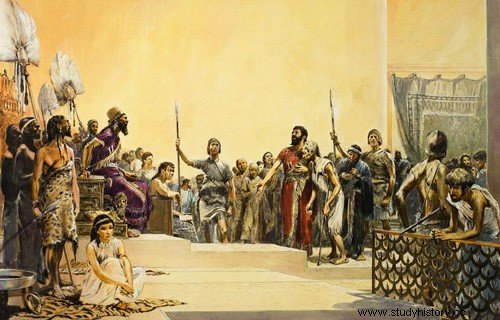
AROUND 2000 B.C. AD
Mesopotamia is divided:
War is rampant throughout the territory.
The Amorites assert their power:
The Amorites take control of southern Mesopotamia and the lands of Akkad, as well as several cities including Babylon.
Assyria becomes a kingdom:
North of Mesopotamia the Assyrian princes try to impose their power and found a kingdom in Assyria. Shamshi-Addad is an important character of this time, he calls himself "the winner of the universe" but he fails to found a lasting empire.
The Assyrians believe that their lands belong to their main god Ashur, and they give this name to their first capital. They have many other gods and goddesses and fear evil spirits. Assyrian merchants developed a flourishing trade in the major cities of Anatolia.
The Hittites invade Anatolia (now Turkey):
The lands inhabited by the first farmers and herders in Anatolia are called “country of the Hattis”. This is why the Hittites are so called. They come, according to some sources, from the steppes of Russia, according to other sources, from India and Europe. On the other hand, all agree that they are terrible warriors. They drive light chariots and fight with iron weapons stronger than the bronze used by their enemies. Between 2000 and 1750 BC, the Hittites neighbored the Hattis. Around the 19th century BC, the kingdoms of Anatolia were colonized by the Assyrians who transmitted to them the art of writing. In 1750 BC, almost all of Anatolia was in the hands of the Hittites who founded a first kingdom before the real empire took shape.
The Hebrews settle in Canaan:
The Hebrews come from semi-nomadic tribes of the Syrian desert. They are the people of antiquity whose history is told the most. The writings of the bible (old testament) constitute the main written source on this people.

CIRCA 1792 – 1750 BC. AD
Reign of King Hammurabi:
The city-states of Mari, Eshnounna, Larsa and Babylon continue to wage war. It is finally Babylon that wins thanks to the tenacity, prudence and skill of an Amorrite:Hammurabi, son of a king. He becomes king of Babylon and creates the Babylonian Empire thanks to his diplomatic and political skills. In less than 25 years, he constituted a veritable empire which was not only the work of a conqueror, but also that of an administrator and a scholar. Centralization is extreme, although the cities keep their own administration. However, Hammurabi manages and controls all the economic activity of the country:amount of wages, price of goods, amount of taxes and duties, etc. Babylon becomes the religious and cultural capital of Mesopotamia. Hammurabi sets up a code of punishments for the subjects of his empire which he has engraved on stone columns for everyone to see. This code of laws is intended to provide future princes with a model of wisdom. After its conception, it was widely distributed in major cities. The code includes approximately 282 articles grouped by theme:Theft, assault and battery, exercise of various professions, etc. For each offence, the code assigns a precise rate, according to the rank of the victim:
If a surgeon performs an operation that results in the death of his patient, his hand is severed! – If an architect builds a house that collapses and kills someone, he is put to death. – A man who owes money to another can lend his wife to him as a slave. – If someone breaks a limb to an awilou (notable), we will break a limb. If he gouges out the eye of a mushkenu (simple peasant), or if he breaks his limb, he will pay a mine of silver.
Although appearing barbaric, these punishments give off the image of a society of free men. Landlords, peasants, craftsmen, merchants, civil servants, priests, lower class (moushkenou), slaves, prisoners of war, sold children, insolvent debtors, etc., everyone is protected by law. They can marry, even with a free woman, have a family, practice a trade, own property, redeem their freedom or be freed. The woman also appears with her legal status. When Hammurabi dies, his empire weakens .
CIRCA 1770 – 1560 BC. AD
The Hebrews leave Canaan and immigrate to Egypt.
AROUND 1,650 B.C. AD
Constitution of the Hittite Empire:
Thanks to a series of conquests, the powerful Hittite sovereign Hattusili I unified the peoples of Anatolia who had remained independent until then. He transformed the small Hittite kingdom into a veritable empire and chose Hattousas (Bogozkôy in present-day Turkey) as his new capital, which became the most prestigious and safest of the city-states.
To protect themselves, the Hittites build gigantic walls which masterfully marry the relief around the capital. Subsequently, the Hittite Empire experienced periods of fabulous conquests, but also periods of trouble, civil wars and rebellion.
CIRCA 1595 B.C. AD
The Hittites ransack Babylon:
The city and temple of Marduk are looted and the Babylonian Empire collapses. The statues of the god Marduk and the deity Zarpanitum associated with him are carried away.
the Kassites invade Babylon:
The Kasites come from the Zagros Mountains (east of Mesopotamia – the largest assembly line in present-day Iraq) and are elite fighters. Experts in the art of raising horses, they have perfected a very maneuverable chariot which ensures them mastery of the battlefields for a very long time. They had already threatened the first dynasty of Babylon with their raids, but it was only after the Hittites sacked the city that one of their rulers took power over the city. They reign over Babylon for almost 400 years and introduce important changes that lead to the multiplication of large villages. The Kassites serve the greatness of Babylon by revitalizing agriculture, commerce, techniques and the arts. The Kasites adopt the Babylonian pantheon of the Amorites and elevate Marduk as the champion of the gods.
CIRCA 1550-1200 BC. AD
Much of Canaan is under the domination of the Egyptians.

AROUND 1,400 B.C. AD
The Canaanites invent the first alphabet of twenty-seven letters.
CIRCA 1380-1340 BC. AD
The Hittite Empire is growing:
After a period of stagnation, the Hittite Empire was reborn under the reign of the sovereign Souppilouliouma.
AROUND 1,300 B.C. AD
Two tribes called the Persians and the Medes invade Persia.
ABOUT 1,274 B.C. AD
Hittites fight Egyptians at Kadesh:
The Hittites and Egyptians are mortal enemies. Neither will emerge victorious from this terrible battle, but later the two civilizations will eventually make peace.
AROUND 1,250 B.C. AD
The Hebrews conquer the lands of Canaan:
the Hebrews return to Canaan and after several battles they conquer territories, settle and cultivate the land.

AROUND 1,200 B.C. AD
The Phoenicians:
The Phoenicians (who are the descendants of the Canaanites) were wealthy and powerful for over 200 years. They become the most prosperous navigators and merchants of antiquity. The main trading ports of Phoenicia are Tyre, Sidon and Byblos. Protected by powerful ramparts, they each have their own king who lives in a luxurious palace. The Phoenicians are skilled craftsmen, they are known for their delicate ivory carvings, their pearls and their magnificent glass bottles. Using a shell called murex, they make an expensive “purple” dye. They are skilled navigators and criss-cross the entire southern Mediterranean Sea where they establish trading posts and colonies. They circumnavigate Africa and probably reach the British Isles. The Phoenicians invent a simple 22-letter alphabet that will gradually evolve into the one we use today.
Learn more about the New Kingdom in Egypt and the Egyptians during antiquity.
Useful link:
Article on the Louvre website: Code Hammurabi, Babylonian Empire – Louvre Museum in Paris
